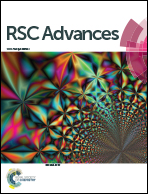Fluorinated silsesquioxane-based photoresist as an ideal high-performance material for ultraviolet nanoimprinting†
Abstract
In this study, we developed a new kind of functional photoresist based on octamethacrylated polyhedral oligomeric silsesquioxane (MAPOSS) and fluorinated monomer as an ideal material for ultraviolet nanoimprint lithography (UV-NIL). We first optimized the synthesis of MAPOSS using the hydrolysis and condensation reactions of methacryloyl oxygen propyl trimethoxysilane. The hybrid photoresist formulations with MAPOSS and fluorinated additive were found to be effective materials for high-performance UV-NIL, which exhibited a preferable curing rate, Young's modulus and thermal stability. Additionally, the low shrinkage and low surface energy of the curing film allows for easier transfer of relief features with excellent imprint reliability for UV-based NIL techniques. These characteristics of fluorinated silsesquioxane-based photoresists make them suitable as inexpensive and convenient components in UV-NIL processes.


 Please wait while we load your content...
Please wait while we load your content...